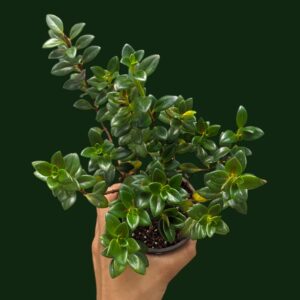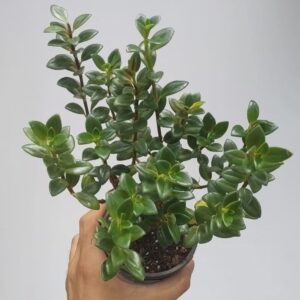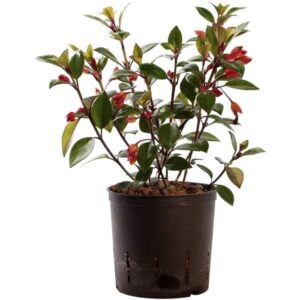How to Grow & Care for Goldfish Plant
The Goldfish Plant (Nematanthus gregarious) is a striking tropical houseplant known for its glossy green leaves and vibrant, orange to red tubular flowers that resemble tiny goldfish. Native to the rainforests of Central and South America, it thrives in warm, humid conditions and adds a splash of color to indoor spaces. Its trailing stems make it perfect for hanging baskets, and with proper care, it blooms prolifically throughout the year. Loved for both its foliage and unique blooms, the Goldfish Plant is a favorite among houseplant enthusiasts.
| Common Name | Goldfish plant, clog plant, flying goldfish plant |
| Botanical Name | Columnea, Nematanthus gregarious |
| Family | Gesneriaceae |
| Plant Type | Perennial |
| Mature Size | 2-3 ft. long, 2 ft. wide |
| Sun Exposure | Partial |
| Soil Type | Well-drained |
| Soil pH | Acidic |
| Flower Color | Red, orange, yellow, pink |
| Native Areas | Central America, Caribbean |
Goldfish Plant Care
- Needs: Bright, indirect light.
- Spring & Summer: Keep soil slightly moist, not soggy.
- Prefers high humidity (above 50%).
- Thrives between 65–75°F (18–24°C).
- Use a well-draining mix (e.g., African violet mix or peat + perlite).
- Reduce feeding in fall and winter.
- Trim faded flowers and dead leaves regularly.
Water
Water the goldfish plant when the top inch of soil feels dry, keeping the soil consistently moist but never soggy. Use room-temperature water and ensure proper drainage to prevent root rot. Reduce watering in winter. Mist regularly to maintain humidity, especially in dry indoor environments.
Light
The Goldfish Plant thrives in bright, indirect light. It needs plenty of filtered sunlight to bloom well, making it ideal for east- or north-facing windows. Avoid direct sun, which can scorch its leaves. Low light slows growth and reduces flowering, so maintain consistent, bright conditions for healthy foliage and blooms.
Soil
Goldfish plants thrive in light, well-draining soil that retains some moisture without becoming soggy. A mix of peat moss and perlite or African violet potting mix works well. Good drainage is essential to prevent root rot. Avoid heavy, compact soils that hold too much water and restrict root growth.
Temperature and Humidity
The Goldfish Plant thrives in warm temperatures between 65–75°F (18–24°C) and needs high humidity to grow well. Avoid cold drafts or temperatures below 60°F. Maintain humidity above 50% by misting regularly or using a humidifier. Warm, moist conditions help promote lush growth and continuous blooming.

Fertilizer
Fertilize your Goldfish Plant every 2–4 weeks during spring and summer with a balanced liquid fertilizer (like 10-10-10) to promote healthy growth and flowering. Avoid over-fertilizing, and reduce feeding in fall and winter when the plant’s growth slows. Always apply to moist soil to prevent root burn.
Pruning
Pruning a Goldfish Plant encourages fuller, bushier growth and enhances flowering. Regularly pinch back leggy stems and remove dead or yellowing leaves. After blooms fade, trim old flowers to promote new ones. Pruning also helps maintain shape and prevents the plant from becoming too long or sparse over time.
Repotting
Repot the goldfish plant every 2–3 years or when it becomes rootbound. Choose a slightly larger pot with drainage holes and use fresh, well-draining soil. Repotting in spring encourages healthy growth and blooming. Gently loosen the roots during repotting and water lightly to help the plant adjust to its new container.
Propagation
Propagation of Goldfish Plant (Nematanthus gregarious) is easy and rewarding, especially when done during the growing season—spring or early summer. The most effective method is using stem cuttings. Choose healthy, non-flowering stems about 4–6 inches long. Snip just below a node and remove the lower leaves. You can root the cuttings in either water or moist potting soil (preferably a light mix of peat and perlite). Keep the cuttings in a warm, humid environment with bright, indirect light. Roots usually begin to form within 2–4 weeks. If rooting in water, change the water every few days to prevent rot. Once well-rooted, transfer the cuttings to a pot with well-draining soil. Keep the young plant evenly moist and avoid direct sun. Propagation not only multiplies your collection but also helps rejuvenate older, leggy plants by encouraging fuller growth. It’s an excellent way to share this beautiful trailing plant with friends or family.

Types of Goldfish Plants
1. Nematanthus gregarious
- The classic and most popular type.
- Produces bright orange, fish-shaped flowers.
- Compact with thick, shiny green leaves.
2. Nematanthus ‘Black Gold’
- Features dark green leaves with deep maroon undersides.
- Flowers are vivid orange-red.
- Striking foliage makes it a decorative houseplant year-round.
3. Nematanthus ‘Tropicana’
- Known for its yellow-orange blooms.
- Leaves are lighter green and slightly more elongated.
- Blooms more frequently in bright light.
4. Nematanthus ‘Lollipop’
- Compact variety ideal for small hanging pots.
- Flowers are deep red to orange, with a glossy finish.
- Great for tabletop displays or terrariums.
5. Nematanthus wettsteinii
- Often confused with N. gregarious.
- Has smaller, rounder leaves and slightly smaller flowers.
- Trailing growth makes it ideal for hanging baskets.
Problem and Solution of Goldfish Plant
| Problem | Cause | Solution |
| Yellow Leaves | Overwatering | Let soil dry, ensure drainage |
| Leaf Drop | Temp shock, dry air | Stabilize environment, raise humidity |
| No Flowers | Low light or nutrients | More light, fertilize, winter rest |
| Leggy Growth | Low light | Increase brightness, pinch stems |
| Brown Tips | Dry air, salt | Boost humidity, flush soil |
| Root Rot | Overwatering | Repot, trim roots, improve drainage |
| Pests | Dry air or neglect | Neem oil, soap spray, isolate |
Read Also: How to Grow and Care for Sago Palm
Goldfish Plant FAQ
1. What is a Goldfish Plant?
Answer: The Goldfish Plant (Nematanthus gregarious) is a tropical houseplant known for its small, orange to red flowers that resemble goldfish. It’s a trailing plant ideal for hanging baskets, loved for its glossy leaves and vibrant blooms.
2. How much light does a Goldfish Plant need?
Answer: It thrives in bright, indirect light. Too little light will prevent blooming, while too much direct sun can scorch the leaves.
3. How often should I water my Goldfish Plant?
Answer: Water when the top 1 inch of soil feels dry. Keep the soil moist (not soggy) in spring and summer. Reduce watering in fall and winter.
4. Why are the leaves turning yellow?
Answer: Yellow leaves are usually caused by overwatering, poor drainage, or low humidity. Allow the soil to dry slightly between waterings and ensure proper drainage.
5. Why isn’t my Goldfish Plant blooming?
Answer: Common causes include low light, lack of nutrients, or no rest period in winter. Provide bright, indirect light, fertilize during growing months, and reduce watering in winter to encourage blooms.
Conclusion
The Goldfish Plant is a stunning and rewarding houseplant known for its unique, goldfish-like blooms and lush trailing foliage. With the right balance of light, water, warmth, and humidity, it can thrive indoors and bloom beautifully throughout the year. While it may require a bit more attention than other common houseplants, the vibrant flowers and decorative appeal make the effort worthwhile. Whether placed on a sunny windowsill or hanging in a bright corner, the Goldfish Plant adds a touch of tropical charm to any space. With proper care and attention, it will reward you with lush growth and eye-catching blooms season after season.




Pingback: how to Grow ZZ Plant: Complete Guide for Beginners -